Городская инфраструктура доклад на английском
Обновлено: 03.05.2024
Цель: совершенствование и развитие навыков устной и письменной речи, навыков чтения и перевода текста профессиональной направленности на английском языке.
Содержание работы
1. Active Words and Word Combinations:
as well as – а так же
surface– поверхность
Grand Duke – Великий герцог
significant – значительный
to flow through – течь через
church – церковь
masterpiece of architecture – шедевр архитектуры
scientific – научный
magnificent – великолепный
Tsar-cannon – Царь пушка
Tsar-bell – Царь колокол
Read and translate the text
THE CAPITAL OF OUR COUNTRY — MOSCOW
Moscow is the capital of Russia. It is the main economic, political, educational and cultural centre of our country.
In Moscow there are most important state institutions. The Parliament and the Government of Russia are seated here as well as the President.
Moscow is a modern mega polis. With over 10 million people it is one of the most populated in the world. It is also one of the largest with the surface of 880 sq km.
Moscow has a long history. It was founded over 800 years ago by Grand Duke Yury Dolgoruki in 1147. In the beginning it was a rather unimportant town, but year after year it grew into a significant city when, finally, in the 16 th century it became the capital of the country. For the period from 1712 to 1917 the capital was moved to St Petersburg.
Moscow is situated on the Moskva river, which flows through the whole city.
The heart of the city, the Kremlin, is the city inside the city. It was built in the 12 th century. There are many churches and museums inside the Kremlin as well as various governmental institutions. The Kremlin is a real masterpiece of architecture.
On the territory of the Kremlin there are the Tsar-cannon and the Tsar-bell which have never been actually used.
There are also many museums and galleries in Moscow holding masterpieces of fine arts.
In Moscow, there are many theatres of world level.
Moscow is also a scientific city. Moscow State University is the oldest and the most important in Russia. It was founded by famous Russian scientist Mikhail Lomonosov in 18 th century.
Moscow is a magnificent city.
3. Answer the following questions:
- What is the capital of Russia?
- How large is the population of Moscow?
- When Moscow was founded?
- By whom Moscow was founded?
- When the Kremlin was build?
- When Moscow did become the capital of Russia?
- What can you see on the territory of the Kremlin?
4. Complete the following sentences:
- Moscow is the main …., …., …. and ….. centre of our country.
- Moscow is a modern …..
- For the period from …. to ….. the capital was moved to ….
- Moscow is situated on the ….
- The heart of the city is ……
- The Kremlin is a real …. of ….
- Moscow State University was founded by …. … in …..
5. Choose the correct variant:
1. Moscow was founded over ….. years ago.
а. 700 b. 800 c. 600
2. Moscow is also one of the largest with the surface of …. sq km.
а. 790 b. 870 c. 880
3. Moscow State University is …. in Russia.
а. the most important b. b. more important c. much important
4. The Parliament and the Government of Russia are seated in Moscow as well as the ….
а. Prime-minister b. President c. State Duma
5. The heart of the city, the Kremlin, is the city ….. the city.
а. inside b. outside c. round
6. Moscow State University was founded by famous Russian ….
а. architect b. scientist c. engineer
7. Moscow is one of …. in the world.
- much populated b. more populated c. the most populated
6. Say true or false:
- In the beginning Moscow was a rather unimportant town.
- Moscow stands on the Lena River.
- The heart of the city is Moscow State University.
- There are many theatres of world level in Moscow.
- On the territory of the Kremlin there are many theatres.
Speak about your native town or village.
Список рекомендуемой литературы:
Цель: совершенствование и развитие навыков устной и письменной речи, навыков чтения и перевода текста профессиональной направленности на английском языке.
Содержание работы
1. Active Words and Word Combinations:
as well as – а так же
surface– поверхность
Grand Duke – Великий герцог
significant – значительный
to flow through – течь через
church – церковь
masterpiece of architecture – шедевр архитектуры
scientific – научный
magnificent – великолепный
Tsar-cannon – Царь пушка
Tsar-bell – Царь колокол
Read and translate the text
THE CAPITAL OF OUR COUNTRY — MOSCOW
Moscow is the capital of Russia. It is the main economic, political, educational and cultural centre of our country.
In Moscow there are most important state institutions. The Parliament and the Government of Russia are seated here as well as the President.
Moscow is a modern mega polis. With over 10 million people it is one of the most populated in the world. It is also one of the largest with the surface of 880 sq km.
Moscow has a long history. It was founded over 800 years ago by Grand Duke Yury Dolgoruki in 1147. In the beginning it was a rather unimportant town, but year after year it grew into a significant city when, finally, in the 16 th century it became the capital of the country. For the period from 1712 to 1917 the capital was moved to St Petersburg.
Moscow is situated on the Moskva river, which flows through the whole city.
The heart of the city, the Kremlin, is the city inside the city. It was built in the 12 th century. There are many churches and museums inside the Kremlin as well as various governmental institutions. The Kremlin is a real masterpiece of architecture.

On the territory of the Kremlin there are the Tsar-cannon and the Tsar-bell which have never been actually used.
There are also many museums and galleries in Moscow holding masterpieces of fine arts.
In Moscow, there are many theatres of world level.
Moscow is also a scientific city. Moscow State University is the oldest and the most important in Russia. It was founded by famous Russian scientist Mikhail Lomonosov in 18 th century.
Moscow is a magnificent city.
3. Answer the following questions:
- What is the capital of Russia?
- How large is the population of Moscow?
- When Moscow was founded?
- By whom Moscow was founded?
- When the Kremlin was build?
- When Moscow did become the capital of Russia?
- What can you see on the territory of the Kremlin?
4. Complete the following sentences:
- Moscow is the main …., …., …. and ….. centre of our country.
- Moscow is a modern …..
- For the period from …. to ….. the capital was moved to ….
- Moscow is situated on the ….
- The heart of the city is ……
- The Kremlin is a real …. of ….
- Moscow State University was founded by …. … in …..
5. Choose the correct variant:
1. Moscow was founded over ….. years ago.
а. 700 b. 800 c. 600
2. Moscow is also one of the largest with the surface of …. sq km.
а. 790 b. 870 c. 880
3. Moscow State University is …. in Russia.
а. the most important b. b. more important c. much important
4. The Parliament and the Government of Russia are seated in Moscow as well as the ….

Одной из самых полезных тематик в изучении любого иностранного языка остается рассказ о населенных пунктах. Именно поэтому описание города на английском языке включают в методические материалы на различных уровнях обучения.
Историческая часть города
Как правило, план описания города начинается с его истории – а она включает в себя не только рассказ о том, как началась его постройка, но и об архитектуре как таковой. В этой части сочинения вам может пригодится следующая лексика и фразы:
I live in (название города)… - Я живу в…
It is my native (home) town… - Это мой родной город.
The city (town) was founded in… - Город был основан в (таком-то году)
It is situated (located) on the … river (lake). – Он расположен на реке (озере) (название озера).
It became the capital… in. – Он стал столицей…(в таком-то году).
The (название) area is the oldest part of the city (town) – Район… - старейшая часть города.
There are such important buildings as….located. – Здесь располагаются такие важные здания как.
There are many old beautiful houses there. – Здесь есть немало красивых старинных домов.
Рассказывая про город на английском, стоит обратить внимание на разницу в смысловых значениях между city и town. Когда мы говорим о большом городе промышленного или иного значения, в котором к тому же располагается правительство области или округа, то к нему более применимо слово city. Если город небольшой, провинциальный или же не имеет каких-либо градообразующих предприятий, в этом случае уместно использовать town.
Подобное разделение связано с языковыми процессами в средневековом английском, где city называли соборный город или столицу, обнесенную крепостной стеной, а словом tun, от которого произошло town – любую усадьбу, двор или особняк.
Современная часть города
Важнейший аспект для создания полноценного описания города на английском языке – это, конечно же, рассказ о его современной части в частности и всем населенном пункте в целом. Здесь вы можете использовать преимущественно описательную лексику, отражающее ваше собственное восприятие города – а потому вам будут полезны следующие слова и фразы:
- attractive – привлекательный;
- mesmerizing – завораживающий;
- lovely – милый;
- provincial – сонный, захолустный, провинциальный;
- bustling – шумный, суетливый;
- inspiring – вдохновляющий;
- charming – очаровательный;
- contemporary – современный;
- well-maintained – благоустроенный;
- lively – оживленный;
- safe – безопасный;
- picturesque – живописный;
- touristic – туристический;
- boring – унылый, скучный;
- area – район;
- district – район, округ;
- suburb –пригород;
- dwelling house – многоквартирный дом.
The contemporary part of town is… - Современной частью города считается…
There are all government buildings… - Там находятся все правительственные здания.
It is the business part of the city… - Это деловая часть города.
There are a lot of offices. – Здесь много офисных зданий.
This area is bustling with life. – Жизнь в этом районе кипит.
Транспорт
Следующий этап – рассказ о транспортной системе города. Здесь вам пригодятся следующие слова и выражения:
- public transport – общественный транспорт
- a bus - автобус
- a trolley bus - троллейбус
- a tram – трамвай
- tube/subway – метро
- local train/suburban train – электричка, пригородный поезд
- a plane – самолет
- an airport – аэропорт
- a railway station – вокзал
- a bus stop – автобусная остановка.
- You can go there by… - Вы можете добраться туда на.. (вид транспорта).
Достопримечательности
Важнейший аспект рассказа о каком-либо населенном пункте – достопримечательности города на английском языке. Сюда могут входить церкви, соборы, необычные постройки и прочие памятники архитектуры, а также музеи, театры, площади и даже культурные центры. Разумеется, в каждом городе они свои, поэтому предложить вам мы можем базовую лексику – узнавать, как звучат названия туристических мест города на английском, в каждом отдельном случае следует самостоятельно.
- sights/landmarks – достопримечательности, памятники архитектуры
- places of interest – достопримечательности, интересные места
- sightseeing – осмотр достопримечательностей
- achurch- церковь
- a cathedral - собор
- a palace – дворец
- a castle – замок
- a monument – памятник
- a museum – музей
- a theatre – театр
- a square – площадь
- … is one of the oldest and the most beautiful landmark in the city. - … - один из старейших и красивейших архитектурных памятников города.
- It was built/constructed in (год) by (имя архитектора). – Он был построен (имя архитектора) в (год)…
Инфраструктура
Владеющие языком на уровне средний и выше уже вполне способны перейти к такому аспекту как описание улицы города на английском. Как правило, оно включает рассказ о важнейших для жизни объектах, а также указание их местоположения.
- a café - кафе
- a restaurant - ресторан
- a mall – торговый центр
- a hospital - больница
- a supermarket - супермаркет
- a drugstore - аптека
- a bank - банк
- a police station – отделение полиции
- a post office - почта
- a school – школа.
- a library - библиотека
- a university - университет
- On the right there is… - Справа находится…
- left - слева
- behind - сзади
- forward - впереди
- next to – рядом с…
Ориентирование по городу: фразы
Описание того, как пройти туда-то или туда-то в рассказе о городе встречается нечасто – как правило, на продвинутых уровнях владения английским. Однако связанная с данным аспектом лексика всегда вам пригодится как в разговоре, так и ориентировании в незнакомом городе.
Could you tell me the way to… ?- Вы не могли бы подсказать мне, как пройти к…
It is on the … Street. – Это на такой-то улице.
Could you please tell me where … is? – Не подскажете, где находится…?
Go straight ahead and then turn (left|right) – Идите прямо, затем поверните направо (налево)
Turn the corner and then walk two quarters ahead. – Поверните за угол и пройдите два квартала прямо.
- on - на
- at - у
- in - в
- on the right - справа
- on the left - слева
- at the corner - на углу
- near, next to - рядом, возле
- in front of - напротив
- between - между
- across - через
- along - вдоль
- above - над
- below - ниже
- opposite to - напротив
- behind - за
Итак, теперь вы знаете, как составлять рассказ о населенном пункте по всем правилам. Тщательно изучив лексику и грамматику, связанную с данной темой, вы вряд ли столкнетесь с какими-либо сложностями – в том числе и при выполнении такого задания как описание города на английском с переводом. Самое главное – узнать правильные названия местных достопримечательностей, и у вас все получится!
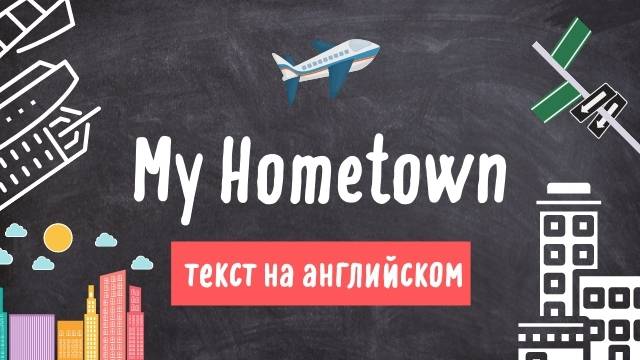
My Hometown или My Homecity?
Отмечу такой момент. Вы наверняка знаете, что town — это маленький городок, а city — большой город. Кажется логичным, что, если вы из Москвы, то нужно писать homecity, не так ли? На самом деле, не совсем так. Слово homecity в принципе возможно и понятно, но обычно под hometown подразумевают родной город независимо от его размеров. Вот пример из Cambridge Dictionary:
He was born in Miami, but he considers New York his hometown since he’s lived there most of his life. — Он родился в Майами, но считаю Нью Йорк своим родным городом, так как прожил там большую часть жизни.
Пройдите тест на уровень английского:
My Hometown — Мой город. Сочинение на английском языке + аудио
It is a very lively place, located in Central Russia. It was founded in 1221. Back then it used to be a major trading hub. People from all over the country came to Nizhny Novgorod to buy and sell goods. Now it has a population of one million and five hundred thousand citizens, it is the 6th biggest city in Russia.
Nowadays it is a large city with a big city center and suburbs. A lot of companies have their headquarters in Nizhny Novgorod. It is one of the biggest economic centers in Russia.
Of course, each city has its advantages and disadvantages. Let’s start with the advantages. There are many ways of transportation in Nizhny Novgorod. You can travel by bus, by trolley, you can even take the underground. Also, Nizhny Novgorod has an advantageous geographical location because it is located between two major cities — Moscow and Kazan.
However, there are also some disadvantages. First of all, it is very dirty and noisy because of traffic jams. Second, it hasn’t got a lot of public areas, such as parks, where you can spend your time with friends. Third, life here is pretty expensive, and the prices of houses and apartments are quite high.
Ниже идет тот же текст, но с переводом. Обратите внимание на выделенные слова – я выделил наиболее примечательные пары “слово-перевод”.
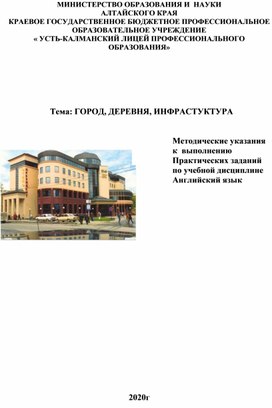
Цель данных методических указаний ввести студентов в область иноязычного письменного общения по специальности и помочь усвоению минимума содержания программы и в выполнении ими контрольных работ.
Задачей методических указаний является совершенствование и обогащение знаний о том, как пройти в городе за рубежом, уметь правильно запрашивать информацию и реагировать на полученный ответ (направления, знаки и т.д.). Методические указания также нацелены на развитие и закрепление как диалогических, так и монологических навыков и умений, необходимых для чтения и понимания оригинальной литературы и применения этих знаний при сдаче дифференцированного зачета.
1. УКАЗАНИЯ ПО ВЫПОЛНЕНИЮ ПРАКТИЧЕСКИХ ЗАДАНИЙ
Практическое задание 1.
TOWN DESCRIPTION
( Описание города )
1. INTRODUCTORY TEXT
Exercise 1.1. Read the text about Sydney. Here are the five headings. Write them in the correct place.
How to have a good time in Sydney
Sydney has everything you want in a city. It’s beautiful, it has old and new buildings, there are fantastic beaches, and the food is delicious.
1. The best times to visit are spring and autumn. In summer it is very hot.
2. There are cheap hotels in King’s Cross. A room is about $50 a night. There are international hotels in the centre. Here a room is about $150 a night.
3. Sydney has theatres and cinemas, and of course, the Opera House. The best shops are in Pitt Street.
Go to the harbor. There beaches, walks, parks, and cafes and, of course, the wonderful bridge.
Sydney has the famous Bondi Beach. People go swimming, surfing, windsurfing, and sailing.
For night-life, there are clubs and bars in Oxford Street.
4. There are restaurants from every country – Italian, Turkish, Lebanese, Japanese, Thai, Chinese, and Vietnamese. Australians eat a lot of seafood – it’s very fresh!
5. There are fast trains and slow buses. The best way to see Sydney is by ferry.
Практическое задание 2.
Найдите перечисленные места на карте и составьте предложения возле чего они находятся и по какой улице к ним можно проехать: bank , chemist , cinema , post office , newsagent , church , supermarket , railway station , internet caf é.
Например : Go down King’s Road. Turn right at the Grand Hotel into Charles Street. It ’ s next to the cinema .
Используйте предлоги, приведенные на рисунке:
Практическое задание 3.
Прочитайте комикс о Ричарде . Дополните фразы следующими словами bridge, building, road, steps, taxi, airport, statue, stairs, park, and river.
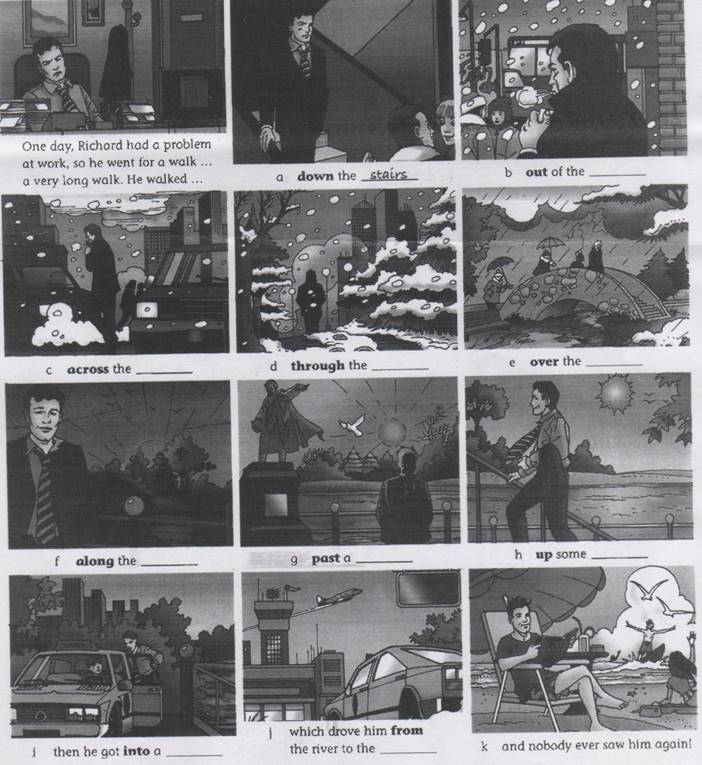
Практическое задание 4.
Посмотрите на все знаки. Какие знаки вы можете увидеть:
1.In the street? 2. In a park? 3. At an airport?
4. In a hospital ? 5. In a museum ?
Запишите их в 5 колонок .
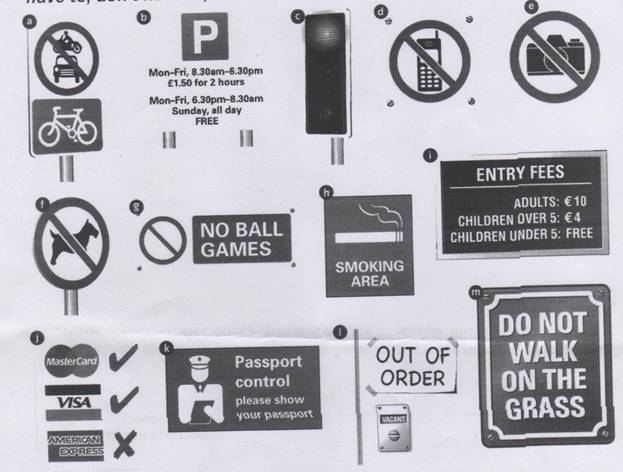
Практическое задание 5
Повторите знаки и составьте предложения, используя have to , don ’ t have to , can or can ’ t .
2. You ___________play football here.
3. You____________take photos.
4. Adults and children over 5_____________pay, but children under 5_____pay.
5. You_________use this toilet.
6.You___________use Visa or Mastercard but you ______use American Express.
7. You___________show your passport.
8. You ____________use a mobile in here.
9. You___________walk on paths, but not the grass.
10. You_____________smoke in this area.
Практическое задание 6
Составьте карту на английском языке и ниже опишите своему иностранному другу как пройти к каждому пункту ( A , B , C , D , etc )
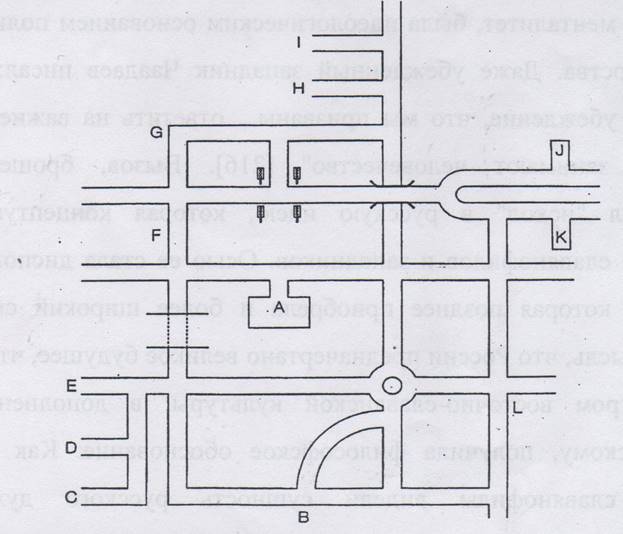
Практическое задание 7
Составьте диалог ( 10-15 предложений), используя следующие фразы
22. take a bus – поехать на автобусе
24.go on foot – идти пешком
26.Go straight as far as the first turning to the right. – идите до первого поворота направо .
27.Ask the conductor to put you down in …street. – попросите кондуктор высадить вас на улице …
28.It's just two steps from here. – это в двух шагах отсюда .
29.I'm afraid it's a long way from here. – боюсь , что это далеко отсюда .
30.It's just round the corner. – это прямо за углом .
31.Go straight ahead till you come to… - идите прямо , пока не дойдете до …
32.All fares, please. – оплатите проезд .
33.Are you getting off at the next stop? – вы выходите на следующей остановке ?
ПРИМЕРНЫЕ КРИТЕРИИ ОЦЕН ИВАНИЯ САМОСТОЯТЕЛЬНОЙ РАБОТЫ
СПИСОК ЛИТЕРАТУРЫ
1. Ажищев Н.И., Суэта Ф.С. Пособие по английскому языку для строительных техникумов. М. Высшая школа, 1978.
2. Безручко Е.Н. Английский для архитекторов. Ростов-на-Дону.
4. Кадырова И.А., Сафарова Р.З. Vehicle . ( Course of Technical
English.) Ufa. 2002.
5. Парахина А.В., Пособие по переводу технических текстов с английского языка на русский. М. Высшая школа, 1982.
Читайте также:

